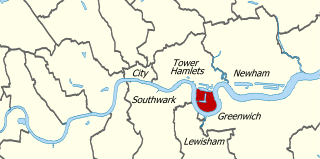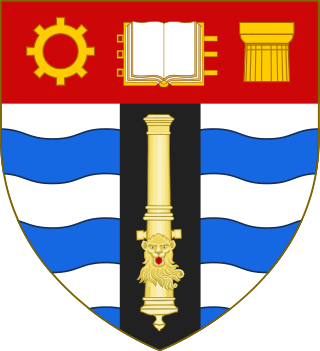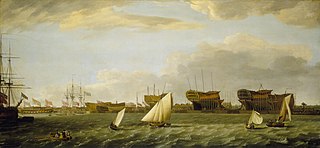Related Research Articles

The Isle of Dogs is a large peninsula bounded on three sides by a large meander in the River Thames in East London, England, which includes the Cubitt Town, Millwall and Canary Wharf districts. The area was historically part of the Manor, Hamlet, Parish and, for a time, the wider borough of Poplar. The name had no official status until the 1987 creation of the Isle of Dogs Neighbourhood by Tower Hamlets London Borough Council. It has been known locally as simply "the Island" since the 19th century.

Woolwich is a town in southeast London, England, within the Royal Borough of Greenwich.

Greenwich is a town in south-east London, England, within the ceremonial county of Greater London. It is situated 5.5 miles (8.9 km) east-south-east of Charing Cross.
The Port of London is that part of the River Thames in England lying between Teddington Lock and the defined boundary with the North Sea and including any associated docks. Once the largest port in the world, it was the United Kingdom's largest port as of 2020. Usage is largely governed by the Port of London Authority ("PLA"), a public trust established in 1908; while mainly responsible for coordination and enforcement of activities it also has some minor operations of its own.

Woolwich Dockyard was an English naval dockyard along the river Thames at Woolwich in north-west Kent, where many ships were built from the early 16th century until the late 19th century. William Camden called it 'the Mother Dock of all England'. By virtue of the size and quantity of vessels built there, Woolwich Dockyard is described as having been 'among the most important shipyards of seventeenth-century Europe'. During the Age of Sail, the yard continued to be used for shipbuilding and repair work more or less consistently; in the 1830s a specialist factory within the dockyard oversaw the introduction of steam power for ships of the Royal Navy. At its largest extent it filled a 56-acre site north of Woolwich Church Street, between Warspite Road and New Ferry Approach; 19th-century naval vessels were fast outgrowing the yard, however, and it eventually closed in 1869. The former dockyard area is now partly residential, partly industrial, with remnants of its historic past having been restored.

The University of Greenwich is a public university located in London and Kent, United Kingdom. Previous names include Woolwich Polytechnic and Thames Polytechnic.

HMS Neptune was a 98-gun second-rate ship of the line of the Royal Navy. She served on a number of stations during the French Revolutionary and Napoleonic Wars and was present at the Battle of Trafalgar in 1805.

His Majesty's Naval Base, Portsmouth is one of three operating bases in the United Kingdom for the Royal Navy. Portsmouth Naval Base is part of the city of Portsmouth; it is located on the eastern shore of Portsmouth Harbour, north of the Solent and the Isle of Wight. For centuries it was officially known as HM Dockyard, Portsmouth: as a Royal Dockyard, Portsmouth functioned primarily as a state-owned facility for building, repairing and maintaining warships; for a time it was the largest industrial site in the world.

Greenwich and Woolwich is a constituency represented in the House of Commons of the UK Parliament since 2015 by Matthew Pennycook of the Labour Party.

Greenwich was a constituency in south-east London, which returned at first two, then one member (MP) to the House of Commons of the UK Parliament. It existed from 1832 to 1997. Elections used the first past the post system; when this elects more than one member, it is sometimes called plurality-at-large voting.

The Jubilee Walkway is an official walking route in London. It was originally opened as the Silver Jubilee Walkway to commemorate Queen Elizabeth II's accession; the Queen herself opened it on 9 June 1977 during her silver jubilee celebrations. The intention was to connect many of London's major tourist attractions and it is now one of seven such walks within the Mayor of London's strategic walking routes. Its length is 15 miles.

Sir Thomas Slade was an English naval architect best known for designing the Royal Navy warship HMS Victory, which served as Lord Nelson's flagship at the Battle of Trafalgar in 1805.

HMS Trafalgar was a 120-gun first-rate ship of the line of the Royal Navy, launched on 21 June 1841 at Woolwich Dockyard. HMS Trafalgar was the last ship to complete the successful Caledonia class.

Blackwall Yard is a small body of water that used to be a shipyard on the River Thames in Blackwall, engaged in ship building and later ship repairs for over 350 years. The yard closed in 1987.

Sir Maurice Fitzmaurice CMG was an Irish civil engineer. He was apprenticed to Benjamin Baker and worked with him on the Forth Railway Bridge before going to Egypt to build the Aswan Dam for which he was appointed both a member of the Ottoman Order of the Mejidiye and a companion of the British Order of St Michael and St George. Following this Fitzmaurice was Chief Engineer to the London County Council and was responsible for the Blackwall, Rotherhithe and Woolwich tunnels. In later life his consultancy advised on docks and harbours across the British Commonwealth as well as the Sennar Dam in Sudan and he was recognised with the prestigious honour of the presidency of the Institution of Civil Engineers for the 1916-17 session.

HMS Royal Albert was a 121 gun three-decker ship of the Royal Navy launched in 1854 at Woolwich Dockyard. She had originally been designed as a sailing ship but was converted to screw propulsion while still under construction.

Deptford Dockyard was an important naval dockyard and base at Deptford on the River Thames, operated by the Royal Navy from the sixteenth to the nineteenth centuries. It built and maintained warships for 350 years, and many significant events and ships have been associated with it.

HMS Victory is a 104-gun first-rate ship of the line of the Royal Navy. She was ordered in 1758, laid down in 1759, and launched in 1765. With 246 years of service as of 2024, she is the world's oldest naval vessel still in commission.
Thomas Ashburton Picken, known professionally as T. Picken, was a Scottish-born watercolourist, engraver and lithographer working in England between around 1834 and 1875. He worked for the printing firm Day and Haghe for many years, and first came to notice for his lithograph of The Destruction of Both Houses of Parliament when he was only about 16 years old. Although there is no evidence that he travelled abroad, he produced many lithographs of foreign parts after paintings by other artists. He specialised in detailed images of landscape, architecture, events of war, and ships. He produced lithographs of SS Great Eastern and the laying of the Atlantic cable, and he illustrated books.

Thomas Pollard was an 18th-century English shipbuilder, who worked at Deptford, Sheerness, Portsmouth, Woolwich, Plymouth and Chatham Royal Dockyards during the course of his career. He was responsible for HMS Royal Sovereign which played a vital role in the Battle of Trafalgar. Apprenticed as a Shipwright to John Rosewell of the notable Rosewell family at Deptford Dockyard in 1747 for a premium of £52. 10s 0d his father was recorded as being Robert Pollard.Apprentices were usually 16 years old at this time. National Archives ref(IR1 series)18f82 Britain county apprentices. It seems probable therefore that he was born during or before 1731
References
- ↑ Biographical note (Vallejo Gallery).
- ↑ e.g.: Construction of the St. Katharine Docks.
- ↑ e.g.: The Blackwall Railway Terminus, Brunswick Pier and the Brunswick propeller steam vessel
- ↑ e.g.: View of figures in front of Woolwich Arsenal, Greenwich
- ↑ The launch of HMS "Trafalgar" (Artnet record).
- ↑ The launch of HMS "Trafalgar" (Detailed description of painting at Vallejo Gallery).